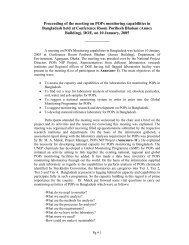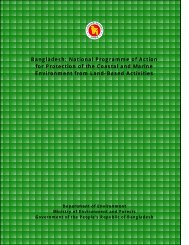Draft CMP HH - the Department of Environment
Draft CMP HH - the Department of Environment
Draft CMP HH - the Department of Environment
You also want an ePaper? Increase the reach of your titles
YUMPU automatically turns print PDFs into web optimized ePapers that Google loves.
Coastal and Wetland Biodiversity Management Project BGD/99/G31<br />
Hakaluki Haor <strong>Draft</strong> Conservation Management Plan<br />
• Introduce <strong>the</strong> zoning concept to local communities and relevant government agencies and raise<br />
awareness about <strong>the</strong> objectives for each zone<br />
• Based on feedback from local communities and relevant government agencies amend <strong>the</strong> zoning<br />
objectives as required<br />
• Develop mechanisms in collaboration with local communities to demarcate <strong>the</strong> zones within <strong>the</strong><br />
ECA, as well as its boundary<br />
• Continue surveying <strong>the</strong> boundary <strong>of</strong> <strong>the</strong> ECA and identifying and defining <strong>the</strong> key socioecological<br />
features that are relevant to <strong>the</strong> overall conservation <strong>of</strong> <strong>the</strong> Haor<br />
• Analyse <strong>the</strong> appropriateness <strong>of</strong> <strong>the</strong> current ECA boundary and propose alternatives should <strong>the</strong>y<br />
be required<br />
Primary Outcome/ Output<br />
• Zonation including boundary assessment is complete and Hakaluki Haor is managed<br />
accordingly<br />
• Zonation maps are produced and distributed to all stakeholders<br />
Constraints<br />
• Time consuming<br />
• Seasonal flooding<br />
• Difficult accessibility<br />
7.2.10 Agriculture<br />
Agricultural production in and around Hakaluki Haor is dominated by <strong>the</strong> growing <strong>of</strong> rice. In <strong>the</strong><br />
past, farmers cultivated <strong>the</strong> many indigenous varieties <strong>of</strong> rice common to <strong>the</strong> region. Being well<br />
adapted <strong>the</strong>se varieties grow well and require only minimal agricultural inputs. However, due to<br />
relatively low yields, production, over <strong>the</strong> years, has increasingly shifted from local indigenous<br />
varieties to <strong>the</strong> use <strong>of</strong> High Yield Varieties (HYV). Although this is economically more rewarding<br />
for local farmers, HYV rice is typically associated with a number <strong>of</strong> environmental concerns such<br />
as rapid soil degradation which usually results in <strong>the</strong> need for <strong>the</strong> application <strong>of</strong> syn<strong>the</strong>tic fertilisers.<br />
Also HYV rice tends to be more prone to attack by pests and disease and to combat this problem<br />
farmers <strong>of</strong>ten rely on a toxic mix <strong>of</strong> herbicides, pesticides and fungicides. These issues are <strong>of</strong><br />
particular to efforts aimed at <strong>the</strong> sound and sustainable management <strong>of</strong> Hakaluki Haor.<br />
With more and more farmers turning to HYV rice for both food security and additional income<br />
purposes, <strong>the</strong>re is a growing concern that this trend will eventually compromise <strong>the</strong> genetic<br />
diversity <strong>of</strong> rice in <strong>the</strong> region with <strong>the</strong> possibility <strong>of</strong> losing local and indigenous rice varieties<br />
altoge<strong>the</strong>r. Although <strong>the</strong> expansion <strong>of</strong> HYV rice is unavoidable, proper management incorporating<br />
<strong>the</strong> promotion and reintroduction <strong>of</strong> local indigenous rice varieties may prove <strong>the</strong> answer to <strong>the</strong><br />
adverse impacts associated with HYV rice production.<br />
Management Actions<br />
• Involve farming communities and relevant government agencies (in particular <strong>the</strong> Bangladesh<br />
Rice Research Institute) to collect agricultural data concerning <strong>the</strong> following:<br />
� Amount <strong>of</strong> land in <strong>the</strong> ECA currently being used for agricultural purposes<br />
� Seasonal fluctuations in area <strong>of</strong> land cultivated<br />
Prepared by UNOPS Consultant Mr. Sulma Warne August/ September 2005 for Project BGD/99/G31 28





